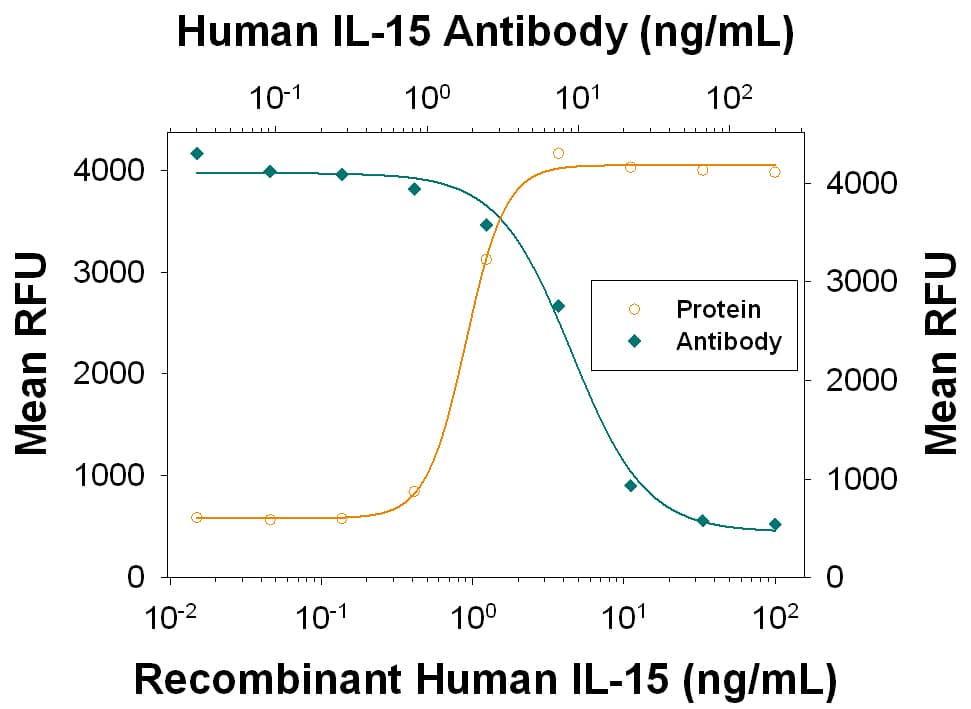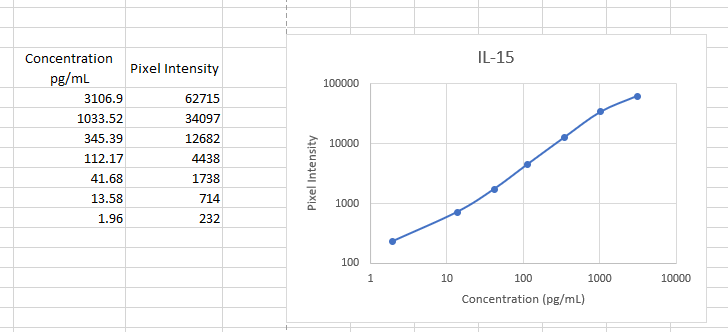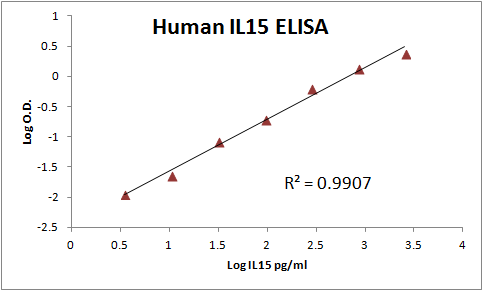Human/Primate IL-15 Antibody Summary
Asn49-Ser162
Accession # P40933
Applications
Human/Primate IL-15 Sandwich Immunoassay
Please Note: Optimal dilutions should be determined by each laboratory for each application. General Protocols are available in the Technical Information section on our website.
Scientific Data
 View Larger
View Larger
Cell Proliferation Induced by IL‑15 and Neutralization by Human IL‑15 Antibody. Recombinant Human IL-15 (Catalog # 247-ILB) induces proliferation in the MO7e human megakaryocytic leukemic cell line in a dose-dependent manner (orange line), as measured by the Resazurin (Catalog # AR002). Proliferation elicited by Recombinant Human IL-15 (3 ng/mL) is neutralized (green line) by increasing concentrations of Mouse Anti-Human/Primate IL-15 Monoclonal Antibody (Catalog # MAB647). The ND50 is typically 4-20 ng/mL.
Reconstitution Calculator
Preparation and Storage
- 12 months from date of receipt, -20 to -70 °C as supplied.
- 1 month, 2 to 8 °C under sterile conditions after reconstitution.
- 6 months, -20 to -70 °C under sterile conditions after reconstitution.
Background: IL-15
Interleukin 15 (IL-15) is a widely expressed 14 kDa cytokine that is structurally and functionally related to IL-2 (1-3). Mature human IL-15 shares 70% amino acid sequence identity with mouse and rat IL-15. Alternate splicing generates isoforms of IL-15 with either a long or short signal peptide (LSP or SSP), and the SSP isoform is retained intracellularly (4). IL-15 binds with high affinity to IL-15 R alpha (5). It binds with lower affinity to a complex of IL-2 R beta and the common gamma chain ( gamma c) which are also subunits of the IL-2 receptor complex (1, 6). IL-15 associates with IL-15 R alpha in the endoplasmic reticulum, and this complex is expressed on the cell surface (7, 8). The dominant mechanism of IL-15 action is known as transpresentation in which IL-15 and IL-15 R alpha are coordinately expressed on the surface of one cell and interact with complexes of IL-2 R beta / gamma c on adjacent cells (9). This enables cells to respond to IL-15 even if they do not express IL-15 R alpha (8, 10). Soluble IL-15-binding forms of IL-15 R alpha can be generated by proteolytic shedding or alternate splicing (11-13). These molecules retain the ability to bind tightly to IL-15 and can either inhibit or augment IL-15 function (5, 12, 13). Consistent with its shared use of IL-2 receptor subunits, IL-15 induces IL-2-like effects in lymphocyte development and homeostasis (3). It is particularly important for the maintenance and activation of NK cells and CD8+ memory T cells (3). IL-15 also exerts pleiotropic effects on other hematopoietic cells and non-immune cells (2). Ligation of membrane-associated IL-15/IL-15 R alpha complexes induces reverse signaling that promotes cellular adhesion, tyrosine phosphorylation of intracellular proteins, and cytokine secretion by the IL-15/IL-15 R alpha expressing cells (14, 15).
- Grabstein, K. et al. (1994) Science 264:965.
- Budagian, V. et al. (2006) Cytokine Growth Factor Rev. 17:259.
- Ma, A. et al. (2006) Annu. Rev. Immunol. 24:657.
- Tagaya, Y. et al. (1997) Proc. Natl. Acad. Sci. USA 94:14444.
- Giri, J.G. et al. (1995) EMBO 14:3654.
- Giri, J. et al. (1994) EMBO J. 13:2822.
- Duitman, E.H. et al. (2008) Mol. Cell. Biol. 28:4851.
- Dubois, S. et al. (2002) Immunity 17:537.
- Stonier, S.W. and K.S. Schluns (2010) Immunol. Lett. 127:85.
- Burkett, P.R. et al. (2004) J. Exp. Med. 200:825.
- Budagian, V. et al. (2004) J. Biol. Chem. 279:40368.
- Mortier, E. et al. (2004) J. Immunol. 173:1681.
- Bulanova, E. et al. (2007) J. Biol. Chem. 282:13167.
- Budagian, V. et al. (2004) J. Biol. Chem. 279:42192.
- Neely, G.G. et al. (2004) J. Immunol. 172:4225.
Product Datasheets
Citations for Human/Primate IL-15 Antibody
R&D Systems personnel manually curate a database that contains references using R&D Systems products. The data collected includes not only links to publications in PubMed, but also provides information about sample types, species, and experimental conditions.
15
Citations: Showing 1 - 10
Filter your results:
Filter by:
-
Hypothermic Ex Situ Perfusion of Human Limbs With Acellular Solution for 24 Hours
Authors: Valentin Haug, Branislav Kollar, Sotirios Tasigiorgos, Yori Endo, Martin Kauke, Ali-Farid Safi et al.
Transplantation
-
Enhanced immune response of MAIT cells in tuberculous pleural effusions depends on cytokine signaling
Sci Rep, 2016-09-02;6(0):32320.
Species: Human
Sample Types: Whole Cells
Applications: Flow Cytometry, Neutralization -
Supplementation of Reduced Gluten Barley Diet with Oral Prolyl Endopeptidase Effectively Abrogates Enteropathy-Associated Changes in Gluten-Sensitive Macaques
Authors: Karol Sestak, Hazel Thwin, Jason Dufour, David X. Liu, Xavier Alvarez, David Laine et al.
Nutrients
-
IL-15 controls T cell functions through its influence on CD30 and OX40 antigens in Celiac Disease.
Authors: Periolo N, Guillen L, Arruvito M, Alegre N, Niveloni S, Hwang J, Bai J, Chernavsky A
Cytokine, 2014-03-14;67(1):44-51.
Species: Human
Sample Types:
-
Epstein-Barr virus coinfection in children boosts cytomegalovirus-induced differentiation of natural killer cells.
Authors: Saghafian-Hedengren S, Sohlberg E, Theorell J, Carvalho-Queiroz C, Nagy N, Persson J, Nilsson C, Bryceson Y, Sverremark-Ekstrom E
J Virol, 2013-10-02;87(24):13446-55.
Species: Human
Sample Types: Whole Cells
Applications: Neutralization -
IL-15:IL-15 receptor alpha superagonist complex: High-level co-expression in recombinant mammalian cells, purification and characterization
Authors: Kai-ping Han, Xiaoyun Zhu, Bai Liu, Emily Jeng, Lin Kong, Jason L. Yovandich et al.
Cytokine
-
Identification of a potent anti-IL-15 antibody with opposing mechanisms of action in vitro and in vivo
Authors: D K Finch, A Midha, C L Buchanan, D Cochrane, R I Craggs, S Cruwys et al.
British Journal of Pharmacology
-
Upregulation of human cytomegalovirus by HIV type 1 in human lymphoid tissue ex vivo.
Authors: Biancotto A, Iglehart SJ, Lisco A, Vanpouille C, Grivel JC, Lurain NS, Reichelderfer PS, Margolis LB
AIDS Res. Hum. Retroviruses, 2008-03-01;24(3):453-62.
Species: Human
Sample Types: Cell Culture Supernates
Applications: Luminex Development -
Effect of serum content and diluent selection on assay sensitivity and signal intensity in multiplex bead-based immunoassays.
Authors: Pfleger C, Schloot N, ter Veld F
J. Immunol. Methods, 2007-10-22;329(1):214-8.
Species: Human
Sample Types: Serum
Applications: Luminex Development -
Abnormal activation and cytokine spectra in lymph nodes of people chronically infected with HIV-1.
Authors: Biancotto A, Grivel JC, Iglehart SJ, Vanpouille C, Lisco A, Sieg SF, Debernardo R, Garate K, Rodriguez B, Margolis LB, Lederman MM
Blood, 2007-02-08;109(10):4272-9.
Species: Human
Sample Types: Cell Culture Supernates
Applications: Luminex Development -
Histological characteristics and altered expression of interleukins (IL) IL-13 and IL-15 in endometria of levonorgestrel users with different uterine bleeding patterns.
Authors: Rhoton-Vlasak A, Hardt N
Fertil. Steril., 2005-03-01;83(3):659-65.
Species: Human
Sample Types: Whole Tissue
Applications: IHC-P -
Clinical improvement in chronic plaque-type psoriasis lesions after narrow-band UVB therapy is accompanied by a decrease in the expression of IFN-gamma inducers -- IL-12, IL-18 and IL-23.
Authors: Piskin G, Tursen U, Sylva-Steenland RM, Bos JD, Teunissen MB
Exp. Dermatol., 2004-12-01;13(12):764-72.
Species: Human
Sample Types: Whole Tissue
Applications: IHC-Fr -
Growth and apoptosis of human natural killer cell neoplasms: role of interleukin-2/15 signaling.
Authors: Yamasaki S, Maeda M, Ohshima K, Kikuchi M, Otsuka T, Harada M
Leuk. Res., 2004-10-01;28(10):1023-31.
Species: Human
Sample Types: Cell Lysates, Whole Cells
Applications: ICC, Western Blot -
NK cell activation by dendritic cells (DCs) requires the formation of a synapse leading to IL-12 polarization in DCs.
Authors: Borg C, Jalil A, Laderach D, Maruyama K, Wakasugi H, Charrier S, Ryffel B, Cambi A, Figdor C, Vainchenker W, Galy A, Caignard A, Zitvogel L
Blood, 2004-07-08;104(10):3267-75.
Species: Human
Sample Types: Whole Cells
Applications: ICC -
Human amniotic fluid lacks interleukin-2 and interleukin-15 but can interact with the beta-chain of the interleukin-2 receptor.
Authors: Searle RF, Bromage SJ, Palmer J, Curry JE, Lang AK
Immunology, 2000-03-01;99(3):411-7.
Species: Human
Sample Types: Amniotic Fluid
Applications: ELISA Development
FAQs
No product specific FAQs exist for this product, however you may
View all Antibody FAQsReviews for Human/Primate IL-15 Antibody
Average Rating: 5 (Based on 2 Reviews)
Have you used Human/Primate IL-15 Antibody?
Submit a review and receive an Amazon gift card.
$25/€18/£15/$25CAN/¥75 Yuan/¥2500 Yen for a review with an image
$10/€7/£6/$10 CAD/¥70 Yuan/¥1110 Yen for a review without an image
Filter by:
Used as an ELISA Capture IgG






